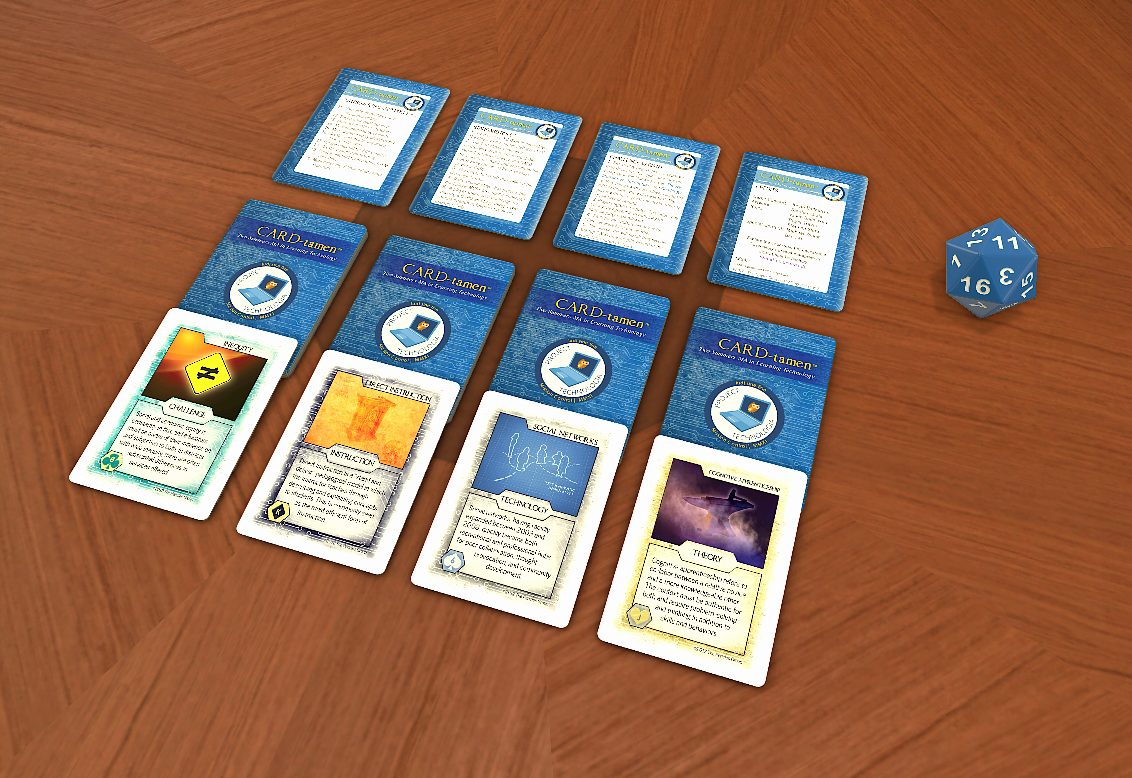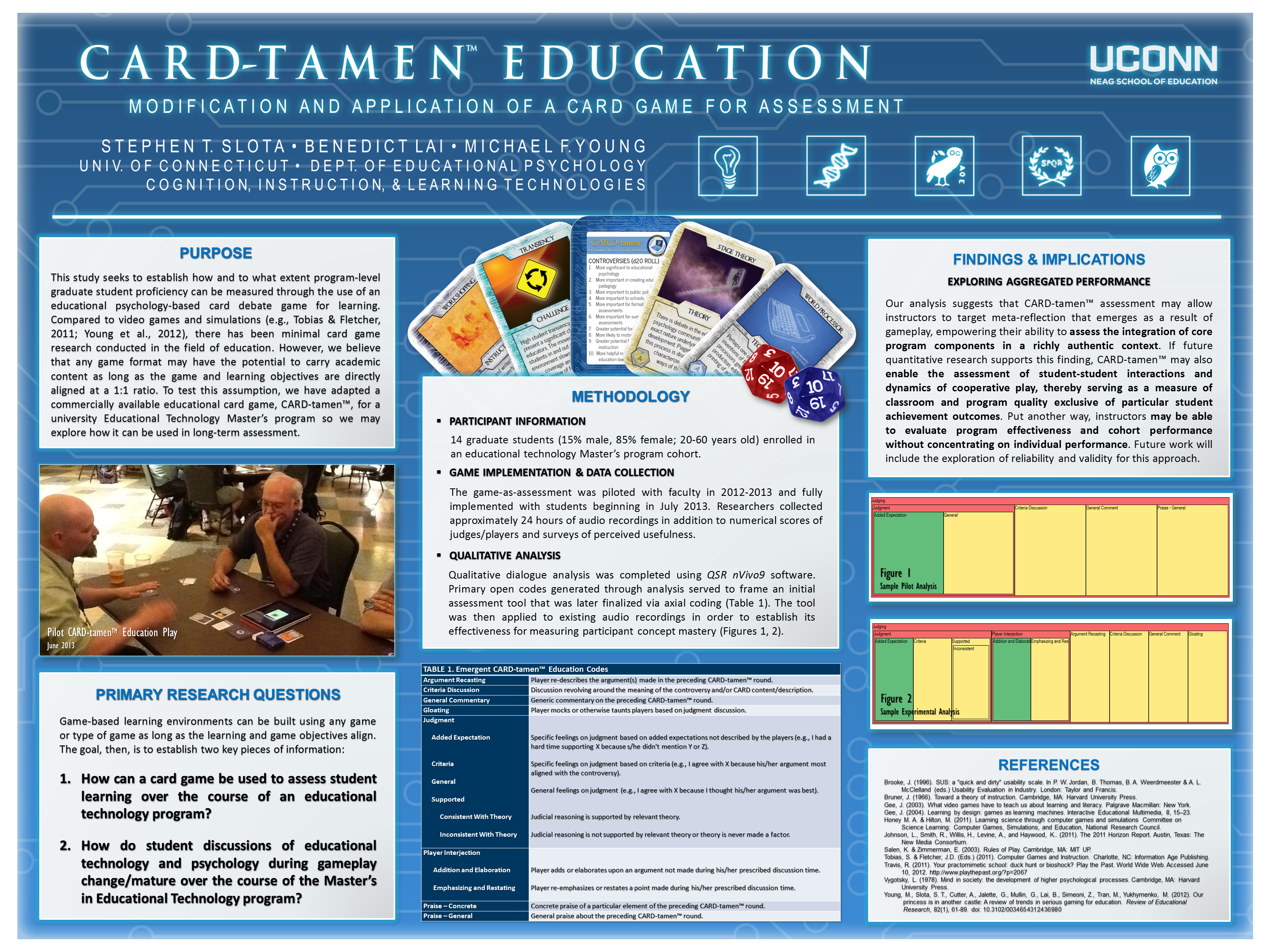
CARD-tamen™ Two Summers is a special edition of the commercially-available game CARD-tamen™ designed to help educators playfully debate the intersection of contemporary content knowledge, pedagogy, learning theory, and instructional technology. In standard play, players rotate through two roles—Judges (i.e., individuals who evaluate player competency) and Provocateurs/Challengers (i.e., individuals tasked with making arguments on behalf of their chosen cards)—to engage in back-and-forth discussion about multiple Educational Technology topics.
A full album of the CARD-tamen™ Two Summers card deck is available HERE.
A FREE, fully-digital, publicly-available version of CARD-tamen™ Two Summers can be accessed HERE (requires installation of Tabletop Simulator to play).


The game consists of:
- One (1) fifty-two (52)-card CARD-tamen™ Two Summers deck:
- Thirteen (13) Pedagogy cards
- Thirteen (13) Learning Theory cards
- Thirteen (13) Technology cards
- Thirteen (13) Challenge cards
- One (1) Controversy card
- One (1) Rule card
- One (1) twenty-sided die
Controversies for play are listed in the table below.
| CARD-tamen™ Two Summers Controversy List | CARD-tamen™ Universal Controversy List (All Decks) |
|
(1) More significant to the learning sciences (2) More important in creating best instructional practices (3) More important to public policy (4) More important to schools (5) More important for creating formative assessments (6) More important for creating summative assessments (7) Greater potential for influencing teacher education (8) Greater potential for influencing STEM instruction (9) Greater potential for influencing literacy instruction (10) More helpful in the development of education law (11) More difficult to address in a classroom setting (12) Engages the most students (13) More appreciated by teachers (14) More appreciated by students (15) More appreciated by administrators (16) Greater potential to cause controversy (17) Greater potential for differentiation (18) Greater potential for learning (19) More likely to motivate (20) More deserving of financial and other resources |
(1) More significant to history (2) Greater cultural impact (3) Inspired more stories (4) More remembered today (5) More essential to survival (6) Greater potential for future study (7) More fascinating (8) Greater continued influence on today’s world (9) More valued by the average person (10) Greater potential to cause controversy (11) More misunderstood (12) Less continued influence on today’s world (13) More complex (14) Less appreciated (15) More aesthetically-significant (16) More loved (17) More feared (18) Greater unsung influence (19) More threatening to humankind (20) More potential for human enlightenment |

There are multiple rulesets for CARD-tamen™ Two Summers, each variant targeting a slightly different set of objectives and providing a slightly different experience. The TPACK Variant, for example, asks players to strategically-integrate technology, pedagogy, content knowledge, and learning theory from the perspective of a technology coordinator, which aligns more directly with the ISTE Standards for Technology Coaches than the Standard Variant.
![]()
- Deal seven (7) cards from a shuffled CARD-tamen™ Two Summers deck to all players. These are the only cards each player will have for the duration of play; DO NOT draw additional cards at the end of each round or upon losing cards.
- The individual who most recently touched their mobile device becomes the round’s Provocateur.
- The Provocateur rolls a twenty-sided die (D20) to identify the round’s controversy (i.e., roll matched to the corresponding number on the CARD-tamen™ Controversies list/card).
- The Provocateur announces the round’s controversy, then selects and reveals the card from their hand that will form the basis of their argument (i.e., the card they believe best addresses the given controversy topic).
- The player to the Provocateur‘s left (clockwise) may either take up the Provocateur‘s challenge or pass. If the player passes, the next player in line MUST take up the challenge.
- The player who accepts the Provocateur‘s challenge becomes the round’s Challenger. Any individual(s) NOT involved in the challenge (i.e., not a Provocateur or Challenger) becomes a Judge.
- The Challenger selects and reveals a card from their own hand to counter the Provocateur‘s.
- Once both cards are revealed, the Challenger has up to two (2) minutes to explain why their chosen card best addresses the given controversy.
- After the Challenger‘s two (2) minutes end, the Provocateur has up to two (2) minutes to make an argument on behalf of their own card.
- After the Provocateur‘s two (2) minutes end, the Challenger has up to one (1) minute to make a rebuttal.
- After the Challenger‘s rebuttal ends, the Provocateur has up to one (1) minute to make a rebuttal.
- After BOTH arguments and rebuttals have ended, the Judge(s) may take up to two (2) minutes to discuss how each debater performed and whether their arguments were persuasive.
- BOTH cards are awarded to the round’s winning player (Provocateur or Challenger). These will be counted as “points” after the final round of gameplay.
- Roles rotate one place to the left (clockwise), and the next player in line becomes the Provocateur.
- Continue in this fashion until one player is out of cards OR at least one (1) full found has been completed (i.e., every player has played as the Provocateur at least one time).
- The winner of CARD-tamen™ Two Summers Standard Variant is the player with the most points (cards) when the game concludes.
![]()
- Separate the CARD-tamen™ Two Summers deck into four (4) face-down piles, one (1) for each card category: Pedagogy, Learning Theory, Technology, and Challenges.
- Reveal one (1) card from the Pedagogy, Learning Theory, and Challenge piles, placing them face-up on the table.
- The individual who most recently touched their mobile device becomes the round’s Judge; all others become the round’s Technology Coaches. From this point forward, roles will rotate in a clockwise fashion at the end of each round.
- When a round starts, the Judge reveals five (5) cards from the Technology pile and announces a specific content objective of their choosing (e.g., ideally topics selected from state and national standards or other curricular guides; e.g., comparing geometric proofs, identifying bacteria types, analyzing Shakespeare’s Hamlet).
- The Technology Coaches (i.e., everyone other than the Judge) have two (2) minutes to review all revealed cards and consider how they might be organized, integrated, and implemented to teach the Judge‘s specified content objective.
- At the end of two (2) minutes, the Technology Coach sitting directly to the Judge‘s left (clockwise) declares which of the five (5) revealed Technology cards (minimum of one; maximum of all five) they will use to make a TPACK integration proposal that addresses the Judge‘s specified content objective. It is NOT mandatory for Technology Coaches to incorporate Instruction, Learning Theory, or Challenge cards into their TPACK integration proposals, but those who do will be awarded bonus points for a successful effort.
- The Technology Coach sitting directly to the Judge‘s left (clockwise) has up to two (2) minutes to present their TPACK integration proposal to the group.
- Once the Technology Coach‘s proposal has been made, non-Judge players (i.e., other Technology Coaches) may offer counter-proposals, spending up to two (2) minutes each presenting alternative approaches to the same problem (incorporating the same face-up Instruction, Learning Theory, and Challenge cards as the initial Technology Coach). Counter-proposals need not rely on the same Technology cards chosen by the initial Technology Coach, but they must use one or more of the already-revealed five Technology cards (i.e., no new cards are revealed during the same round).
- Once all proposals and counter-proposals are made, the Judge awards a range of one (1) to three (3) points to the winning proposal. Justification for selecting the winner must be rooted in the technology integration strategies described by the TPACK-L framework. (1 point: Player uses Technology and Pedagogy cards to meet the Judge‘s stated content objective; 2 points: Player uses Technology, Pedagogy, and Learning Theory cards to meet the Judge‘s stated content objective; 3 points: Player uses Technology, Pedagogy, and Learning Theory cards to meet the Judge‘s stated content objective AND address the challenge presented on the Challenge card).
- After points are awarded, the Technology Coach to the Judge‘s left (clockwise) becomes the Judge for the next round. Replace any/all cards used for the round’s winning proposal with new cards drawn from their respective piles.
- Play continues until a single player accumulates (10) points OR all players have served as the Judge at least one time (i.e., completing one full rotation around the table).
- The winner of CARD-tamen™ Two Summers TPACK Variant is the first player to accumulate ten (10) points OR the player with the most points when the game concludes.
